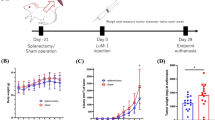Abstract
A xenogeneic human head and neck squamous cell carcinoma (HNSCC) model in immunocompetent mice was evaluated for its requirement of cyclosporine for progressive tumor growth. Tumor growth and T cell functions were assessed in mice receiving cyclosporine treatment for various lengths of time. Tumor cells were injected s.c. on day 1 and cyclosporine was injected i.p. daily on days 1, 1–7, 1–14, 1–21, or for the entire 28 days of tumor growth. All mice developed tumors. These tumors were confirmed to be squamous carcinomas of human origin histologically and by positive staining for human MHC class I antigen expression. Tumors were largest in mice that received cyclosporine for days 1–21 or days 1–28. Increased tumor size was associated with increased serum levels of tumor-reactive antibodies, an increased intratumoral frequency of CD4+ and CD8+ cells, but a diminished production of interleukin-2 (IL-2) by the tumor infiltrate. Also correlating with increasing tumor size was splenomegaly, a decline in the frequency, but not the absolute levels, of splenic CD4+ and CD8+ cells, and a diminished capacity to proliferate in response to concanavalin A and to be stimulated to secrete IL-2. The HNSCC tumors contributed to the immune decline since T cell functions were more depressed in the tumor bearers than in control mice receiving only cyclosporine treatment. These results demonstrate that human HNSCC tumor xenografts can grow in mice even with limited cyclosporine treatment, and that the survival of these xenografts may, in part, be due to a tumor-induced decline in select T cell functions.
Similar content being viewed by others
References
Braun DP, Ahn M, Harris JE, Chu E, Casey L, Wilbands G, Siziopikou KP (1993) Sensitivity of tumoricidal function in macrophages from different anatomical sites of cancer patients to modulation of arachidonic acid metabolism. Cancer Res 53: 3362
Matsumura T, Sussman JJ, Krinoch RA, Chang AE, Shu S (1994) Characteristics and in vivo homing of long-term T-cell lines and clones derived from tumor-draining lymph nodes. Cancer Res 54: 2744
McGrath PC, Hamby LS, Freeman JW (1992) Phorbol dibutyrate plus ionomycin improves the generation of cytotoxic T cells from draining lymph nodes of patients with advanced head and neck cancer. Am J Surg 164: 610
Zocchi MR, Ferrarini M, Rugarli C (1990) Selective lysis of the autologous tumor by delta TCS1+ gamma/delta+ tumor-infiltrating lymphocytes from human lung carcinomas. Eur J Immunol 20: 2685
Takahashi H, Nakada T, Puisieux I (1993) Inhibition of human colon cancer growth by antibody-directed human LAK cells in SCID mice. Science 259: 1460
Katz AE (1993) Update on immunology of head and neck cancer. Med Clin N Am 77: 625
Wanebo HJ, Blackinton D, Kouttab N, Mehta S (1993) Contribution of serum inhibitory factors and immune cellular defects to the depressed cell-mediated immunity in patients with head and neck cancer. Am J Surg 166: 389
Lakhdar M, Ben Aribia MH, Maalej M, Ladgham A (1991) Selective homing of phenotypically lytic cells within nasopharyngeal carnicoma biopsies: numerous CD8- and CD16-positive cells in the tumor. Int J Cancer 48: 57
Lapointe H, Lampe H, Banerjee D (1992) Head and neck squamous cell carcinoma cell line-induced, suppression of in vitro lymphocyte proliferative responses. Otolaryngology 106: 149
Rice SQ, Crane IJ, Scully C, Prime SS (1992) Production of a suppressor of lymphocyte proliferation by two human oral carcinoma cell lines. Scand J Immunol 36: 443
Wanebo HJ, Riley T, Karz D, Pace RC, Johns ME, Cantrell RW (1988) Indomethacin sensitive suppressor-cell activity in head and neck cancer patients. The role of the adherent mononuclear cell. Cancer 61: 462
Chakraborty NG, Ergin MT, Mukherji B (1991) Suppressor function of lymphocytes activated in in vitro co-culture against autologous tumor cells and expanded in interleukin-2. In Vivo 5: 631
Bursuker I, Petty BA, Neddermann KM, Keller LS (1991) Immunomodulation in an apparently non-immunogenic murine tumor. Int J Cancer 49: 414
Letessier EM, Sacchi M, Johnson JT, Heberman RB, Whiteside TL (1990) The absence of lymphoid suppressor cells in tumor-involved lymph nodes of patients with head and neck cancer. Cell Immunol 130: 446
O'Mahony AM, O'Sullivan GC, O'Connell J, Cotter TG, Collins JK (1993) An immune suppressive factor derived from esophageal squamous carcinoma induces apoptosis in normal and transformed cells of lymphoid lineage. J Immunol 151: 4847
Rabinowich H, Vitolo D, Altarac S, Herberman RB, Whiteside TL (1992) Role of cytokines in the adoptive immunotherapy of an experimental model of human head and neck cancer by human IL-2-activated natural killer cells. J Immunol 149: 340
Jacobson HI, Bennett JA, Mizejewski GJ (1990) Inhibition of estrogen-dependent breast cancer growth by a reaction product of alpha-fetoprotein and estradiol. Cancer Res 50: 415
Kaartinen M, Eray M, Lehtonen E, Matoso-Ferreira A, Tienari J (1994) Implanted solid human tumours grow under the renal capsule of cyclosporin-immunosuppressed rats. Scand J Immunol 39: 618
Calne RY, Watson CJ, Brons IG, Makisalo H, Metcalfe SM, Sriwatanawongsa V, Davies HS (1994) Tolerance of porcine renal allografts induced by donor spleen cells and seven days' treatment with cyclosporine. Transplantation 57: 1433
Spinelli A, Gurley KE, Hall BM (1993) Specific unresponsiveness in rats with prolonged cardiac allograft survival after treatment with cyclosporine. V. Dependence of CD4+ suppressor cells on the presence of alloantigen and cytokines, including interleukin 2. Transplantation 55: 374
Author information
Authors and Affiliations
Additional information
This study was supported by the Medical Research Service of the Department of Veterans Affairs, by grants CA-45080 and CA-48080 from the National Institutes of Health
Rights and permissions
About this article
Cite this article
Taitz, A., Petruzzelli, G., Pak, A.S. et al. Immune parameters of mice bearing human head and neck cancer. Cancer Immunol Immunother 40, 283–291 (1995). https://doi.org/10.1007/BF01519627
Received:
Accepted:
Issue Date:
DOI: https://doi.org/10.1007/BF01519627




